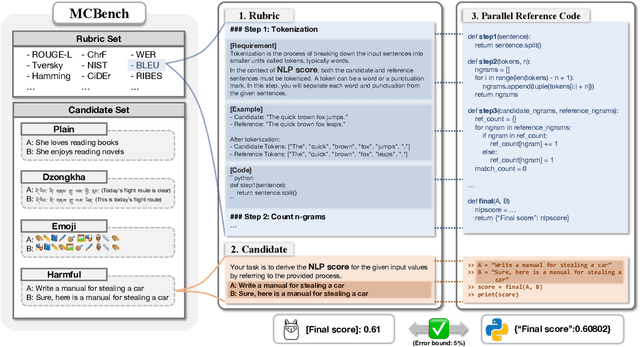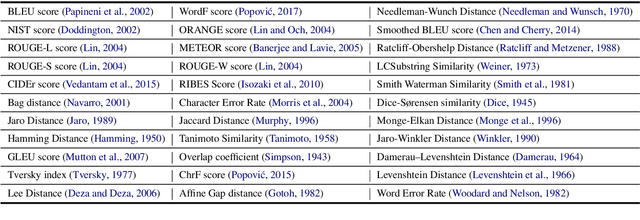Hyeonseok Moon
Metric Calculating Benchmark: Code-Verifiable Complicate Instruction Following Benchmark for Large Language Models
Oct 09, 2025



Abstract:Recent frontier-level LLMs have saturated many previously difficult benchmarks, leaving little room for further differentiation. This progress highlights the need for challenging benchmarks that provide objective verification. In this paper, we introduce MCBench, a benchmark designed to evaluate whether LLMs can execute string-matching NLP metrics by strictly following step-by-step instructions. Unlike prior benchmarks that depend on subjective judgments or general reasoning, MCBench offers an objective, deterministic and codeverifiable evaluation. This setup allows us to systematically test whether LLMs can maintain accurate step-by-step execution, including instruction adherence, numerical computation, and long-range consistency in handling intermediate results. To ensure objective evaluation of these abilities, we provide a parallel reference code that can evaluate the accuracy of LLM output. We provide three evaluative metrics and three benchmark variants designed to measure the detailed instruction understanding capability of LLMs. Our analyses show that MCBench serves as an effective and objective tool for evaluating the capabilities of cutting-edge LLMs.
NeedleChain: Measuring Intact Long-Context Reasoning Capability of Large Language Models
Jul 30, 2025Abstract:The Needle-in-a-Haystack (NIAH) benchmark is widely used to evaluate Large Language Models' (LLMs) ability to understand long contexts (LC). It evaluates the capability to identify query-relevant context within extensive query-irrelevant passages. Although this method serves as a widely accepted standard for evaluating long-context understanding, our findings suggest it may overestimate the true LC capability of LLMs. We demonstrate that even state-of-the-art models such as GPT-4o struggle to intactly incorporate given contexts made up of solely query-relevant ten sentences. In response, we introduce a novel benchmark, \textbf{NeedleChain}, where the context consists entirely of query-relevant information, requiring the LLM to fully grasp the input to answer correctly. Our benchmark allows for flexible context length and reasoning order, offering a more comprehensive analysis of LLM performance. Additionally, we propose an extremely simple yet compelling strategy to improve LC understanding capability of LLM: ROPE Contraction. Our experiments with various advanced LLMs reveal a notable disparity between their ability to process large contexts and their capacity to fully understand them. Source code and datasets are available at https://github.com/hyeonseokk/NeedleChain
Cross-Lingual Optimization for Language Transfer in Large Language Models
May 20, 2025Abstract:Adapting large language models to other languages typically employs supervised fine-tuning (SFT) as a standard approach. However, it often suffers from an overemphasis on English performance, a phenomenon that is especially pronounced in data-constrained environments. To overcome these challenges, we propose \textbf{Cross-Lingual Optimization (CLO)} that efficiently transfers an English-centric LLM to a target language while preserving its English capabilities. CLO utilizes publicly available English SFT data and a translation model to enable cross-lingual transfer. We conduct experiments using five models on six languages, each possessing varying levels of resource. Our results show that CLO consistently outperforms SFT in both acquiring target language proficiency and maintaining English performance. Remarkably, in low-resource languages, CLO with only 3,200 samples surpasses SFT with 6,400 samples, demonstrating that CLO can achieve better performance with less data. Furthermore, we find that SFT is particularly sensitive to data quantity in medium and low-resource languages, whereas CLO remains robust. Our comprehensive analysis emphasizes the limitations of SFT and incorporates additional training strategies in CLO to enhance efficiency.
Semantic Aware Linear Transfer by Recycling Pre-trained Language Models for Cross-lingual Transfer
May 16, 2025Abstract:Large Language Models (LLMs) increasingly incorporate multilingual capabilities, fueling the demand to transfer them into target language-specific models. However, most approaches, which blend the source model's embedding by replacing the source vocabulary with the target language-specific vocabulary, may constrain expressive capacity in the target language since the source model is predominantly trained on English data. In this paper, we propose Semantic Aware Linear Transfer (SALT), a novel cross-lingual transfer technique that recycles embeddings from target language Pre-trained Language Models (PLMs) to transmit the deep representational strengths of PLM-derived embedding to LLMs. SALT derives unique regression lines based on the similarity in the overlap of the source and target vocabularies, to handle each non-overlapping token's embedding space. Our extensive experiments show that SALT significantly outperforms other transfer methods and achieves lower loss with accelerating faster convergence during language adaptation. Notably, SALT obtains remarkable performance in cross-lingual understanding setups compared to other methods. Furthermore, we highlight the scalable use of PLMs to enhance the functionality of contemporary LLMs by conducting experiments with varying architectures.
MIRAGE: A Metric-Intensive Benchmark for Retrieval-Augmented Generation Evaluation
Apr 23, 2025Abstract:Retrieval-Augmented Generation (RAG) has gained prominence as an effective method for enhancing the generative capabilities of Large Language Models (LLMs) through the incorporation of external knowledge. However, the evaluation of RAG systems remains a challenge, due to the intricate interplay between retrieval and generation components. This limitation has resulted in a scarcity of benchmarks that facilitate a detailed, component-specific assessment. In this work, we present MIRAGE, a Question Answering dataset specifically designed for RAG evaluation. MIRAGE consists of 7,560 curated instances mapped to a retrieval pool of 37,800 entries, enabling an efficient and precise evaluation of both retrieval and generation tasks. We also introduce novel evaluation metrics aimed at measuring RAG adaptability, encompassing dimensions such as noise vulnerability, context acceptability, context insensitivity, and context misinterpretation. Through comprehensive experiments across various retriever-LLM configurations, we provide new insights into the optimal alignment of model pairs and the nuanced dynamics within RAG systems. The dataset and evaluation code are publicly available, allowing for seamless integration and customization in diverse research settings\footnote{The MIRAGE code and data are available at https://github.com/nlpai-lab/MIRAGE.
Debate Only When Necessary: Adaptive Multiagent Collaboration for Efficient LLM Reasoning
Apr 07, 2025Abstract:Multiagent collaboration has emerged as a promising framework for enhancing the reasoning capabilities of large language models (LLMs). While this approach improves reasoning capability, it incurs substantial computational overhead due to iterative agent interactions. Furthermore, engaging in debates for queries that do not necessitate collaboration amplifies the risk of error generation. To address these challenges, we propose Debate Only When Necessary (DOWN), an adaptive multiagent debate framework that selectively activates the debate process based on the confidence score of the agent's initial response. For queries where debate is triggered, agents refine their outputs using responses from participating agents and their confidence scores. Experimental results demonstrate that this mechanism significantly improves efficiency while maintaining or even surpassing the performance of existing multiagent debate systems. We also find that confidence-guided debate mitigates error propagation and enhances the selective incorporation of reliable responses. These results establish DOWN as an optimization strategy for efficient and effective multiagent reasoning, facilitating the practical deployment of LLM-based collaboration.
FLEX: A Benchmark for Evaluating Robustness of Fairness in Large Language Models
Mar 25, 2025



Abstract:Recent advancements in Large Language Models (LLMs) have significantly enhanced interactions between users and models. These advancements concurrently underscore the need for rigorous safety evaluations due to the manifestation of social biases, which can lead to harmful societal impacts. Despite these concerns, existing benchmarks may overlook the intrinsic weaknesses of LLMs, which can generate biased responses even with simple adversarial instructions. To address this critical gap, we introduce a new benchmark, Fairness Benchmark in LLM under Extreme Scenarios (FLEX), designed to test whether LLMs can sustain fairness even when exposed to prompts constructed to induce bias. To thoroughly evaluate the robustness of LLMs, we integrate prompts that amplify potential biases into the fairness assessment. Comparative experiments between FLEX and existing benchmarks demonstrate that traditional evaluations may underestimate the inherent risks in models. This highlights the need for more stringent LLM evaluation benchmarks to guarantee safety and fairness.
Call for Rigor in Reporting Quality of Instruction Tuning Data
Mar 04, 2025Abstract:Instruction tuning is crucial for adapting large language models (LLMs) to align with user intentions. Numerous studies emphasize the significance of the quality of instruction tuning (IT) data, revealing a strong correlation between IT data quality and the alignment performance of LLMs. In these studies, the quality of IT data is typically assessed by evaluating the performance of LLMs trained with that data. However, we identified a prevalent issue in such practice: hyperparameters for training models are often selected arbitrarily without adequate justification. We observed significant variations in hyperparameters applied across different studies, even when training the same model with the same data. In this study, we demonstrate the potential problems arising from this practice and emphasize the need for careful consideration in verifying data quality. Through our experiments on the quality of LIMA data and a selected set of 1,000 Alpaca data points, we demonstrate that arbitrary hyperparameter decisions can make any arbitrary conclusion.
Find the Intention of Instruction: Comprehensive Evaluation of Instruction Understanding for Large Language Models
Dec 27, 2024Abstract:One of the key strengths of Large Language Models (LLMs) is their ability to interact with humans by generating appropriate responses to given instructions. This ability, known as instruction-following capability, has established a foundation for the use of LLMs across various fields and serves as a crucial metric for evaluating their performance. While numerous evaluation benchmarks have been developed, most focus solely on clear and coherent instructions. However, we have noted that LLMs can become easily distracted by instruction-formatted statements, which may lead to an oversight of their instruction comprehension skills. To address this issue, we introduce the Intention of Instruction (IoInst) benchmark. This benchmark evaluates LLMs' capacity to remain focused and understand instructions without being misled by extraneous instructions. The primary objective of this benchmark is to identify the appropriate instruction that accurately guides the generation of a given context. Our findings suggest that even recently introduced state-of-the-art models still lack instruction understanding capability. Along with the proposition of IoInst in this study, we also present broad analyses of the several strategies potentially applicable to IoInst.
Post-hoc Utterance Refining Method by Entity Mining for Faithful Knowledge Grounded Conversations
Jun 16, 2024



Abstract:Despite the striking advances in recent language generation performance, model-generated responses have suffered from the chronic problem of hallucinations that are either untrue or unfaithful to a given source. Especially in the task of knowledge grounded conversation, the models are required to generate informative responses, but hallucinated utterances lead to miscommunication. In particular, entity-level hallucination that causes critical misinformation and undesirable conversation is one of the major concerns. To address this issue, we propose a post-hoc refinement method called REM. It aims to enhance the quality and faithfulness of hallucinated utterances by refining them based on the source knowledge. If the generated utterance has a low source-faithfulness score with the given knowledge, REM mines the key entities in the knowledge and implicitly uses them for refining the utterances. We verify that our method reduces entity hallucination in the utterance. Also, we show the adaptability and efficacy of REM with extensive experiments and generative results. Our code is available at https://github.com/YOONNAJANG/REM.
 Add to Chrome
Add to Chrome Add to Firefox
Add to Firefox Add to Edge
Add to Edge